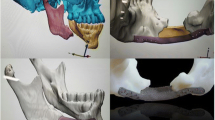Abstract
Based on multi-point forming (MPF) technology, a novel digital manufacturing method of cranial titanium plates for the repair of skull defects is developed in this paper. First, a 3D triangular mesh model of the skull is constructed from a CT data set. Then, a non-uniform rational B-splines-format (NURBS-format) patch surface is obtained by surface interpolation based on the skull polygon model. Finally, the patch surface model is input to MPF CAD/CAM software and the cranial titanium prosthesis is deformed by an MPF press. The method has many new features compared with other means. Implementing medical image processing and MPF technology, the method can remarkably shorten the production cycle of titanium cranioplasty, as well as offer improved fitting precision. About 20 practical applications have been finished, which prove the feasibility and efficiency of the method.
Similar content being viewed by others
References
Carr JC, Fright WR, Beatson RK (1997) Surface interpolation with radial basis functions for medical imaging. IEEE Trans Med Imag 16(1):96–107
Lee M-Y, Chang C-C, Lin C-C et al. (2002) Custom implant design for patients with cranial defects. IEEE Eng Med Biol Mag 21(2):38–44
Mingzhe Li, Yuhong Liu, Shizhong Su et al. (1999) Multi-point forming: a flexible manufacturing method for a 3-d surface sheet. J Mater Process Technol 87:277–280
Cai ZY, Li MZ (2002) Multi-point forming of three-dimensional sheet metal and the control of the forming process. Int J Pressure Vessels Piping 79:289–296
Li MZ, Cai ZY, Sui Z et al. (2002) Multi-point forming technology for sheet metal. J Mater Process Technol 129:333–338
Chen J (2001) The study of multi-point forming CAD and sectional multi-point forming process. Dissertation, Jilin University
Chua CK, Chou SM, Ng SW, Chow KY, Lee ST, Aung SC, Seah CS (1998) An integrated experimental approach to link a laser: a CAD/CAM system and a rapid prototyping system for biomedical applications. Adv Manuf Technol 14:110–115
Chua CK, Chou SM, Lin SC, Eu KH (1998) Rapid prototyping assisted surgery planning. Adv Manuf Technol 14:624–630
Chua CK, The SH, Gay RKL (1999) Rapid prototyping versus virtual prototyping in product design and manufacturing. Adv Manuf Technol 15:597–603
Pigel L, Tiller W (1995) The NURBS book. Springer, Berlin Heidelberg New York
Altobelli DE, Kikinis R, Mulliken JB et al. (1993) Computer-assisted three-dimensional planning in craniofacial surgery. Plast Reconstr Surg 92(4):576–85
Cutting C, Bookstein FL, Grayson B, Fellingham L, McCarthy JG (1986) Three-dimensional computer-assisted design of craniofacial surgical procedures: optimization and interaction with cephalometric and CT-based models. Plast Reconstr Surg 77(6):877–887
Linney AD, Tan AC, Richards J et al. (1993) Three-dimensional visualization of data on human anatomy: Diagnosis and surgical planning. J Audiovis Media Med 16:4–10
Weszka JK (1978) A survey of thresholding techniques. Comput Vis Graph Image Process 7:259–265
Sahoo PK et al. (1988) A survey of thresholding techniques. Comput Vis Graph Image Process 41:233–260
Mehnert A, Jackway P (1997) An improved seeded region growing algorithm. Patt Recogn Lett 18(10):1065–1071
Lin F, Soon SH (1998) An effective 3D seed fill algorithm. Comput Graph 22(5):641–644
Lorensen WE, Cline HE (1987) Marching cubes: a high resolution 3D surface construction algorithm. Comput Graph 21(4):163–169
Author information
Authors and Affiliations
Corresponding author
Rights and permissions
About this article
Cite this article
Chen, JJ., Liu, W., Li, MZ. et al. Digital manufacture of titanium prosthesis for cranioplasty. Int J Adv Manuf Technol 27, 1148–1152 (2006). https://doi.org/10.1007/s00170-004-2309-y
Received:
Accepted:
Published:
Issue Date:
DOI: https://doi.org/10.1007/s00170-004-2309-y




